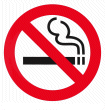Atlanta, GA (PRWEB) December 14 2003--According to New Hope: Avoiding Lung Cancer, smoking shortens the lives of American females by 14.5 years and males by 13.2 years.
While smoking contributes to heart and other disease, the public most often connects it with lung cancer. “Lung cancer is the foremost cancer killer of American men and women,” says author Noel Griese. “More of us die of lung cancer than of breast, prostate and colon cancer combined.”
Who is most at risk of getting lung cancer? People over 55 who have smoked a pack of cigarettes a day for 20 or more years. Females are somewhat more vulnerable than males.
While lung cancer is the biggest killer in the cancer family, says the author, it is the easiest to prevent. Because 87 percent of lung cancer is caused by tobacco, the easiest way to avoid it is never to begin smoking. Short of that, says Griese, a past Georgia director of the American Cancer Society and American Lung Association, current smokers should stop immediately.
“Quitting doesn’t completely eliminate future risk,” says the author, who is editor of Current CancerNews and a past Georgia chairman of the Great American Smokeout. “But as time goes on, risk continues to decline. Quitting also lessens the risk of other smoking-related diseases, including heart attacks, emphysema, chronic obstructive pulmonary disease, stroke, peripheral vascular disease and accelerated hardening of the arteries.”
In the United States, home to 90 million present and former smokers, 171,900 Americans will likely be diagnosed with lung cancer in 2003. An estimated 157,200 will die. In the rest of the world, where 1.2 billion people smoke, tobacco caused about four million deaths in 2002.
Smokers who quit benefit immediately from reduced risk of heart attack. Their red blood cells stop transporting carbon monoxide and begin carrying more healthy oxygen. Lung cancer risk declines more slowly, dropping to half 10 years after the smoker quits. But note, says the author: “Smokers who quit before age 50 halve their risk of dying in the next 15 years compared with those who don’t.”
Griese says early detection of lung cancer is crucial. “Only 14 percent of people diagnosed with lung cancer survive for five years,” he said. “Most die within a year. But if diagnosis is early, when the cancer is still treatable, five-year survival increases to 42 percent on up.”
While the key step in avoiding lung cancer is to quit smoking, other lifestyle changes can reduce overall cancer risk. These include avoiding obesity, eating a low-fat diet, consuming ample dietary fiber, eating lots of cruciferous vegetables like cabbage, broccoli, Brussels sprouts and cauliflower, consuming other vegetables and fruits, avoiding excessive alcohol consumption and eating less salt-cured, smoked and nitrite-cured foods.
New Hope is available in bookstores and online from Anvil Publishers (www.anvilpub.com), Amazon.com, eBay and BNBN.com. It is available as a paperback (ISBN 0-9704975-3-9, $12.95), hardback (ISBN 0-9704975-7-1, $24.95) and eBook (ISBN 0-9704975-6-3, PDF $10.95), 224 pp., LCCN2003-12121. Additional information: www.anvilpub.com or 1-800-500-FLAG. To arrange author interviews and appearances: e-mail protected from spam bots.
FURTHER INFORMATION: Lee Xavier, 770-938-0289; eMail e-mail protected from spam bots
###









